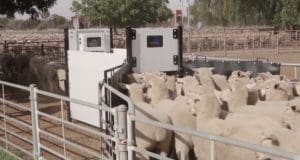 SHEEP flow trials with electronic ear tag scanners are continuing across Victoria this month after a demonstration at the Wycheproof saleyards recently.
SHEEP flow trials with electronic ear tag scanners are continuing across Victoria this month after a demonstration at the Wycheproof saleyards recently.
The Australian Livestock Saleyards Association is running the trials for member saleyards with funding from the Victorian Government as the industry gets ready for the first 2017-drop lambs tagged with mandatory electronic tags.
ALSA executive officer Mark McDonald said a scanner trial was held at the Warracknabeal saleyards today. Trials will continue at Geelong next Monday and at the Bairnsdale saleyards in June.
The trials were being run to mainly determine the best position for scanners in saleyards to maximise sheep flows, he said.
“There are no tagged sheep around and the software is not fully tested or ready yet.
“This is the first phase.”
Scanclear’s Brendan Carey said the trial at the Wycheproof saleyards with a small portable Aleis Delta 6 scanner aimed to show agents and producers that sheep will run through scanners, but also to determine where to correctly locate the equipment.
“It’s about getting the flows and getting the scanners in the right place so we can get the information, which is the ear tag RFID number, into our saleyard software systems.”
Mr McDonald said the recent trials have worked with Aleis equipment, but the Geelong trial will use Hecton hardware and later trials will involve Shearwell Australia.
“We are just testing flows through the scanners pre and post-sale, and running them in and out of pens or having the scanners in the laneways or in the corners.
“We are really only testing scanning locations at this stage.”
Further trials will involve comparison of single and double scanning within saleyards when suitable software is available to reconcile data.
Mr McDonald said at the Wycheproof trial sheep in some locations ran straight through the scanner, but needed assistance in some positions.
“We also collected timings on how long it takes to count sheep in and out, versus running them in and out through a scanner.”
ALSA will compile a report on the trials as part of its contract with Agriculture Victoria, he said.
Click here to see a video of the Wycheproof trial.

This is progress. The technology is there to allow scanning en masse, which will also allow counting pen by pen – an overall improvement for day-to-day handling at the yards. In time it will be a win-win for all interests, which should go nationwide.
It is the throughput with the identification of non-readers, and non-taggers being identified and isolated in a timely manner — with throughputs equivalent to current stockyard movements and at a reasonable sustainable cost for all parties. One of the big questions is how to achieve the above without OH&S and animal welfare problems. There is no doubt it could be done, but at an exorbitant cost for no gain. When the current system can produce the needed results, if all parties carry out their requirements as demonstrated by the NSW exercises, except in a few cases of especially dealer (mixed) mobs and property to property transfers not being recorded as they should. All the problems that occur with the current system will also occur with EIDs for the same reasons.